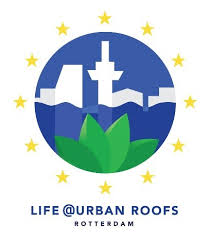
Urban Roofs – LIFE@Urban Roofs – stimulating private investment in climate adaptation – who’s afraid of red, yellow, green and blue
Project Overview
Cities are vulnerable to flooding after extreme rainfall and to heat island effects. Effective adaptation measures are necessary to make cities more resilient to climate change.
Governments working on the development and implementation of adaptation strategies are limited by the scarcity of urban space, the availability of public funds, and regulations and policies that may be in conflict with adaptation goals.
Including roofs and facades in climate adaptation strategies can be an effective way of circumventing the first problem. Roofs on houses, office buildings, hospitals and schools can be used for green infrastructure or water storage.
Stimulating private investment is one way of tackling the lack of availability of public funds, for example by including adaptation measures in building regulations for new projects or renovations. However, such a conventional, top-down approach has a limited effect.
LIFE@Urban Roofs will encourage real estate developers and building owners to invest in climate change adaptation. This new approach will see the local government acting as a stimulator and facilitator.
The project will trial the use of multifunctional roofs that have greater benefits for property owners than traditional green roofs. These roofs will combine several types of infrastructure: green (to reduce the urban heat island effect and support biodiversity), blue (water storage), yellow (energy generation) and red (social use).
To boost innovation, the project will provide roof space for experimental technologies, and will organise a design contest for multifunctional roofs. It will also carry out a social cost benefit analysis (SCBA) of each site. This will allow the designs for each multifunctional roof to be optimised. The adaptation measures will then be implemented.
The effects of the adaptation measures will be monitored. Data will be used to evaluate and validate the demonstration cases. This will lead to the development of a transferrable and replicable blueprint of the approach to stimulate private investment. As part of the LIFE project, Vejle in Denmark will be the first to replicate the approach. It will intensively cooperate with Rotterdam to provide solid evidence of the validity and efficacy of the approach.
Project Results
Expected results include:
- 20 000 m² of additional green infrastructure in the inner city of Rotterdam;
- 950 m³ of additional water storage in the inner city of Rotterdam;
- 11 300 m² of additional infiltration surface at street level in the inner city of Rotterdam; and
- 745 000 kWh/year of sustainable, locally-produced energy;
- A 20% decrease in flooding risk at the demonstration locations;
- A 0.5°C drop in temperature at the demonstration locations;
- A 10% increase in the number of green/multifunctional roofs in the city of Rotterdam;
- A 10% decrease in sealed soil ratios at the demonstration locations;
- A blueprint for collaborative stimulation of private investments in climate adaptation;
- Installation of the multifunctional roofs designed by the two winners of the design contest organised by the project;
- 10 rotating test lots on the experimentation roof to be made available for technology developers and providers to test and validate roof components and technology;
- Replication of the project’s approach in Vejle, Denmark.

